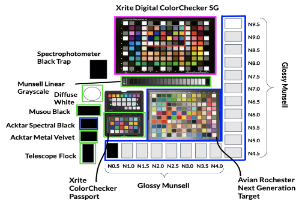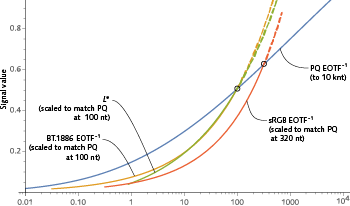
The capability for a camera to produce a color-accurate high dynamic range image is based upon its capture of luminance within a scene as well as the targets chosen to create the color transformation matrix. The wide-ranging luminance within a scene is an important part of cultural heritage documentation to appropriately capture an object's appearance. In addition, color accuracy is critical to documenting cultural heritage appropriately. This research compares prosumer and mobile phone cameras for cultural heritage documentation using single exposure and high dynamic range images. It focuses on the evaluation of color characterization process, color reproduction quality, and generation of the scene. This was done by using two types of prosumer cameras and two types of mobile phone cameras, at 800 lux with a wide range of color targets with various surface textures, matte, semigloss, and glossy. It was found that for creating color calibration matrices, a single exposure outperformed the one created from fusion of multiple exposure images. Additionally, including an extended achromatic scale along with the traditional Macbeth colors as part of the training data for the color calibration matrix may increase color accuracy for different cameras and the samples in the scene.

High dynamic range (HDR) technology enables a much wider range of luminances – both relative and absolute – than standard dynamic range (SDR). HDR extends black to lower levels, and white to higher levels, than SDR. HDR enables higher absolute luminance at the display to be used to portray specular highlights and direct light sources, a capability that was not available in SDR. In addition, HDR programming is mastered with wider color gamut, usually DCI P3, wider than the BT.1886 (“BT.709”) gamut of SDR. The capabilities of HDR strain the usual SDR methods of specifying color range. New methods are needed. A proposal has been made to use CIE LAB to quantify HDR gamut. We argue that CIE L* is only appropriate for applications having contrast range not exceeding 100:1, so CIELAB is not appropriate for HDR. In practice, L* cannot accurately represent lightness that significantly exceeds diffuse white – that is, L* cannot reasonably represent specular reflections and direct light sources. In brief: L* is inappropriate for HDR. We suggest using metrics based upon ST 2084/BT.2100 PQ and its associated color encoding, IC<sub>T</sub>C<sub>P</sub>.

Thus far, there were the difference meaning and interpretation for definition of "Shitsukan". Therefore, there were many studies whether "Shitsukan" can be evaluated quantitatively or not. As one of the past our study, we carried out texture analysis for classification method of texture types by using the Shitsukan Research Database. As a result, we were able to see characteristics between contrast and correlation for texture types. In this paper, we analyzed statistically after comparing between texture analysis for classification method of texture types and luminance information in the Shitsukan Research Database for the free of charge obtained from Web. And then, we obtained novelty and knowledge discussing characteristics of texture types.

Viewers of high dynamic range television (HDR, HDR-TV) expect a comfortable viewing experience with significantly brighter highlights and improved details of darker areas on a brighter display. However, extremely bright images on a HDR display are potentially undesirable and lead to an uncomfortable viewing experience. To avoid the issues, we require specific production guidelines for subjective brightness to ensure brightness consistency between and within programs. To create such production guidelines, it is necessary to develop an objective metric for subjective brightness in HDR-TVs. A previous study reports that the subjective brightness is proportional to the average of displayed pixel luminance levels. However, other parameters can affect the subjective brightness. Therefore, we conducted a subjective evaluation test by using specific test images to identify the factors that affect the perceived overall brightness of HDR images. Our results indicated that positions and distributions of displayed pixel luminance levels on video affect brightness in addition to the average of displayed pixel luminance levels. The study is expected to contribute to the development of an objective metric for subjective brightness.

Physico-realistic simulation of any type of display needs to take into account not only its emissive properties but also its reflective properties which can play a key role in outdoor situations for example. We discuss a method based on Fourier optics viewing angle instruments capable to measure the emissive properties of a display for quasi-all its viewing angle and also its reflective properties versus angle and wavelength very rapidly. More precisely the spectral BRDF of the display surface is measured at different incident angles with a good angular resolution to be able to simulate accurately the unwanted reflections that corrupt display contrast and color. Thanks to the angular dependence, the display aspect for an observer anywhere in front of it can be obtained rapidly for any color image and the impact of the different imperfections can be visualized and quantified. Same experimental data are use in a new generation of spectral ray tracing software. The ray-tracing accuracy is checked by simulations of color images and comparison to analytical calculation of the light emitted and reflected by each pixel of the display.